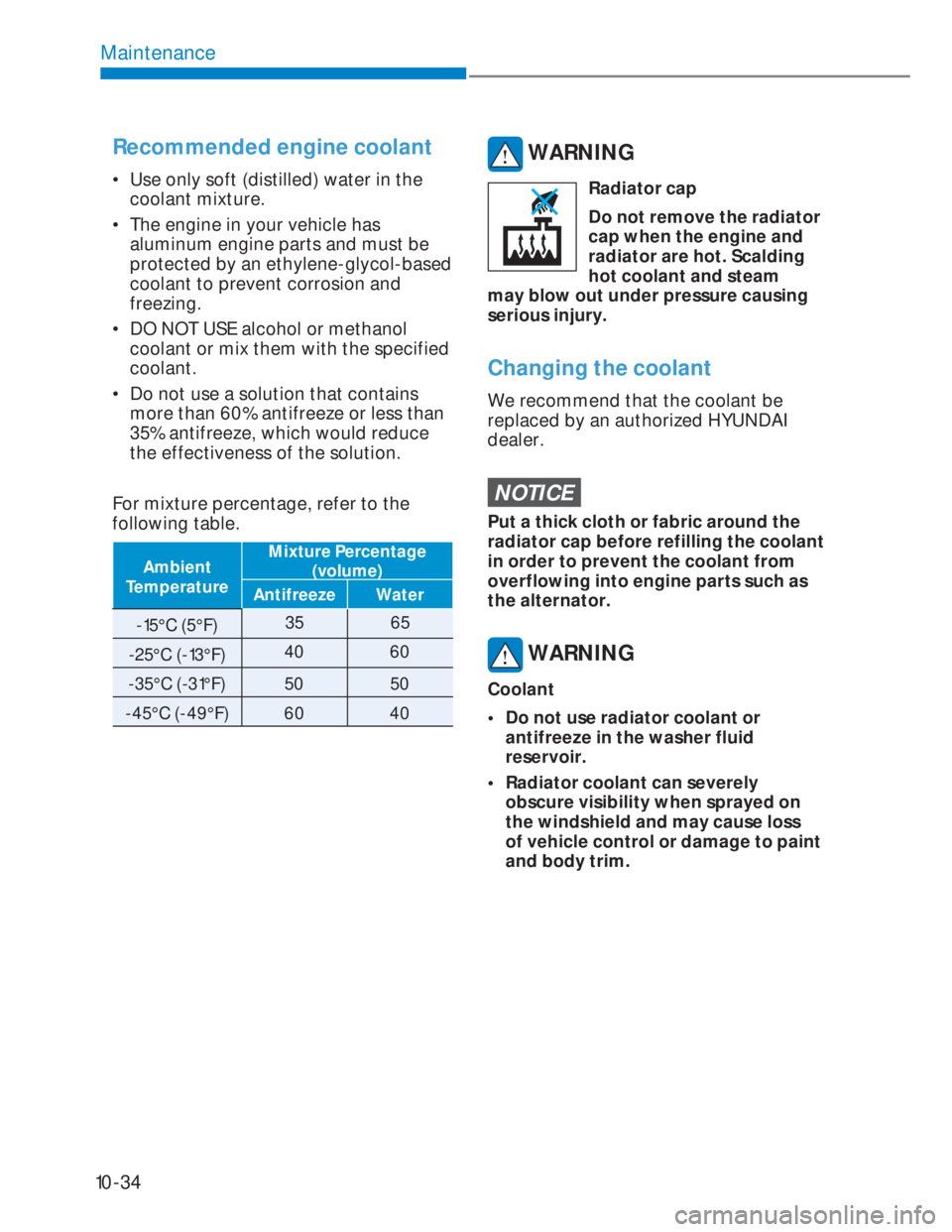Page 364 of 444

10-25
10
Vacuum crankcase ventilation
hoses (if equipped)
Inspect the surface of hoses for
evidence of heat and/or mechanical
damage. Hard and brittle rubber,
cracking, tears, cuts, abrasions, and
excessive swelling indicate deterioration.
Particular attention should be paid to
examine those hose surfaces nearest to
high heat sources, such as the exhaust
manifold.
Inspect the hose routing to assure that
the hoses do not come in contact with
any heat source, sharp edges or moving
component which might cause heat
damage or mechanical wear. Inspect
all hose connections, such as clamps
and couplings, to make sure they are
secure, and that no leaks are present.
Hoses should be replaced immediately if
there is any evidence of deterioration or
damage.
Air cleaner filter
We recommend that the air cleaner filter
be replaced by an authorized HYUNDAI
dealer.
Spark plugs
Make sure to install new spark plugs of
the correct heat range.
WARNING
Do not disconnect and inspect spark
plugs when the engine is hot. You may
burn yourself.
Valve clearance (For 1.0 T-GDi)
Inspect for excessive valve noise and/or
engine vibration and adjust if necessary.
We recommend that the system be
serviced by an authorized HYUNDAI
dealer.
Cooling system
Check cooling system components, such
as radiator, coolant reservoir, hoses and
connections for leakage and damage.
Replace any damaged parts.
Coolant
The coolant should be changed at the
intervals specified in the maintenance
schedule.
Manual transmission fluid
(if equipped)
Inspect the manual transmission fluid
according to the maintenance schedule.
Automated manual transmission
fluid (if equipped)
Inspect the Automated manual
transmission fluid according to the
maintenance schedule.
Page 371 of 444

10-32
Maintenance
The high-pressure cooling system
has a reservoir filled with year-round
antifreeze coolant. The reservoir is filled
at the factory.
Check the antifreeze protection and
coolant level at least once a year, at the
beginning of the winter season, and
before traveling to a colder climate.
NOTICE
• Do not drive with no engine coolant.
It may cause water pump failure and
engine seizure, etc.
• When the engine overheats from
low engine coolant, suddenly adding
engine coolant may cause cracks
in the engine. To prevent damage,
add engine coolant slowly in small
quantities.
Checking the coolant level
OBI3090008OBI3090008
�����„�„Petrol Engine (1.0 T-GDi)Petrol Engine (1.0 T-GDi)
Check the condition and connections
of all cooling system hoses and
heater hoses. Replace any swollen or
deteriorated hoses.
The coolant level should be filled
between F (Full) and L (Low) marked on
the side of the coolant reservoir when
the engine is cool.
If the coolant level is low, add enough
distilled (deionized) water.
Bring the level to F (Full), but do
not overfill. If frequent additions are
required, we recommend that the
system be inspected by an authorized
HYUNDAI dealer.
ENGINE COOLANT
Page 373 of 444

10-34
Maintenance
Recommended engine coolant
• Use only soft (distilled) water in the
coolant mixture.
• The engine in your vehicle has
aluminum engine parts and must be
protected by an ethylene-glycol-based
coolant to prevent corrosion and
freezing.
• DO NOT USE alcohol or methanol
coolant or mix them with the specified
coolant.
• Do not use a solution that contains
more than 60% antifreeze or less than
35% antifreeze, which would reduce
the effectiveness of the solution.
For mixture percentage, refer to the
following table.
Ambient
TemperatureMixture Percentage
(volume)
Antifreeze Water
-15°C (5°F)35 65
-25°C (-13°F)40 60
-35°C (-31°F) 50 50
-45°C (-49°F) 60 40
WARNING
Radiator cap
Do not remove the radiator
cap when the engine and
radiator are hot. Scalding
hot coolant and steam
may blow out under pressure causing
serious injury.
Changing the coolant
We recommend that the coolant be
replaced by an authorized HYUNDAI
dealer.
NOTICE
Put a thick cloth or fabric around the
radiator cap before refilling the coolant
in order to prevent the coolant from
overflowing into engine parts such as
the alternator.
WARNING
Coolant
• Do not use radiator coolant or
antifreeze in the washer fluid
reservoir.
• Radiator coolant can severely
obscure visibility when sprayed on
the windshield and may cause loss
of vehicle control or damage to paint
and body trim.
Page 377 of 444

10-38
Maintenance
Checking the washer fluid level
OBI3090038OBI3090038
Check the fluid level in the washer fluid
reservoir and add fluid if necessary. Plain
water may be used if washer fluid is not
available.
However, use washer solvent with
antifreeze characteristics in cold
climates to prevent freezing.
WARNING
Coolant
• Do not use radiator coolant or
antifreeze in the washer fluid
reservoir.
• Radiator coolant can severely
obscure visibility when sprayed on
the windshield and may cause loss
of vehicle control or damage to the
paint and body trim.
• Windshield washer fluid agents
contain some amounts of alcohol
and can be flammable under certain
circumstances. Do not allow sparks
or flame come in contact with the
washer fluid or the washer fluid
reservoir. Damage to the vehicle or
occupants could occur.
• Windshield washer fluid is poisonous
to humans and animals. Do not drink
and avoid coming in contact with
the windshield washer fluid. Serious
injury or death could occur.
WASHER FLUID